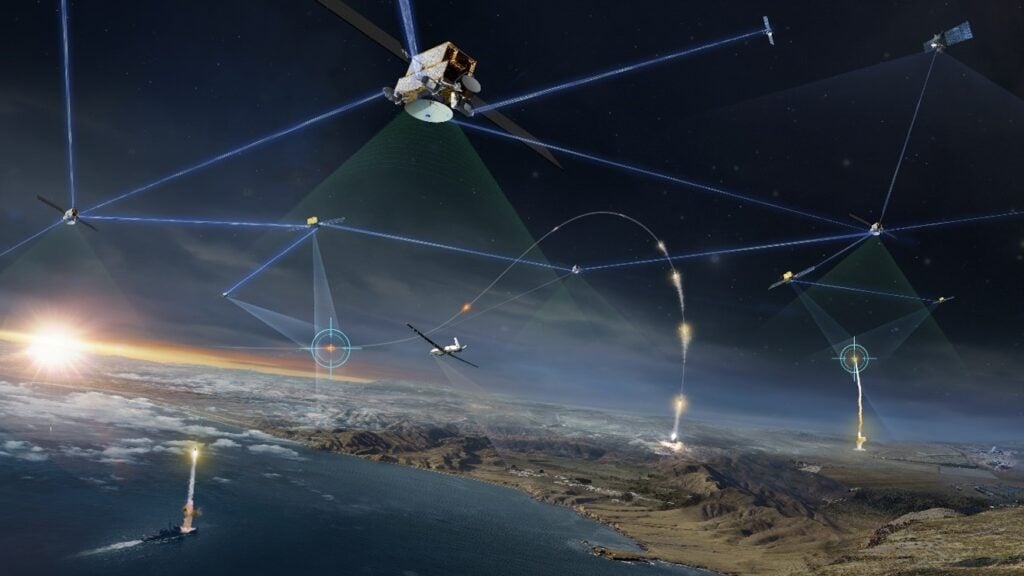
The Space Development Agency will begin launching its Tranche 1 Transport Layer communications mesh network in 2024. (Image: Northrop Grumman)
WASHINGTON — The Space Development Agency is working to develop a “translator” payload to enable intelligence, surveillance and reconnaissance data gathered by commercial and partner agency satellites to be routed to its satellite communications network — which in turn will downlink that data directly to weapons platforms, according to SDA Director Derek Tournear.
“We’re working with partners to build out ‘translator sats,'” he said Tuesday, “that is, a satellite that will be able to basically talk to the SDA Transport Layer and talk to either the commercial or other government agency providers … to move data from one network on to the other.”
The capability to link sensor data to shooters in near real time across all five warfighting domains — land, sea, air, space and cyberspace — is the central premise of the Defense Department’s Joint All Domain Command and Control (JADC2) concept for prosecuting future conflicts. SDA’s planned Transport Layer of data relay satellites in low Earth orbit are being developed to do just that, serving as the JADC2 communications backbone.
“The whole mission, in a nutshell, is to get the right sensor data to the right shooter at the right time,” he said.
In a keynote speech at the Mitchell Institute’s Spacepower Security Forum, Tournear explained that ultimately, the goal is use optical communications links to rapidly and securely route communications and ISR data among satellites and down to weapon systems and warfighters on Earth.
The agency already has developed a baseline standard for optical inter-satellite links (OISLs) that will allow any provider to simply “plug into” its Transport Layer, he noted. And it has stood up a lab in concert with the Naval Research Laboratory where any would-be provider can test their own optical terminals for compatibility.
But “translator” payloads are necessary because many of today’s commercial remote sensing providers do not, and will not, have the ability to equip their satellites with OSILs required to link to SDA’s Transport Layer birds.
In addition, he said, many commercial ISR networks simply cannot meet the cybersecurity standards demanded by SDA — called NEBULA, for Network Established Beyond the Limits of the Atmosphere [PDF].
“They may not be able to meet the NEBULA standard because of crypto requirements and things like that, which is not an easy thing to solve,” he said.
So, in the end, the translator sats will end up being “one of the main ways that we will get the custody data [i.e. sensor data] onto our Transport Layer,” Tournear said.
While it isn’t quite clear whether a payload to equip satellites to serve as translators would be carried by SDA’s own satellites, partner satellites or even those owned by third parties, he explained, SDA and its (unnamed) commercial partners are working to flesh out the payload’s own parameters.
That work, he said, includes three technical challenges:
First, it would include an optical communications terminal that meets the SDA standard. “That’s the easy part,” Tournear said.
The second is developing what he jokingly called “a nebulizer and a de-nebulizer” — in essence the software to reform “whatever networking protocols” are being used by other satellite data providers and “put that into a NEBULA standard format that can be injected into the SDA Transport Layer network.” The agency, he said, is developing the generic “software development toolkits” that vendors could use “as a starting point” for integration efforts.
The final challenge, Tournear said, is cybersecurity to protect the various networks and links between them.
“The third one is, okay, now we need to make sure we work out a proper cybersecurity framework to allow us to take data on and off the network,” he said. “But that’s something that has a lot of different types of solutions based whether those data are coming from a different government system, a commercial system, a contractor operated/government owned … system, things like that.”






















